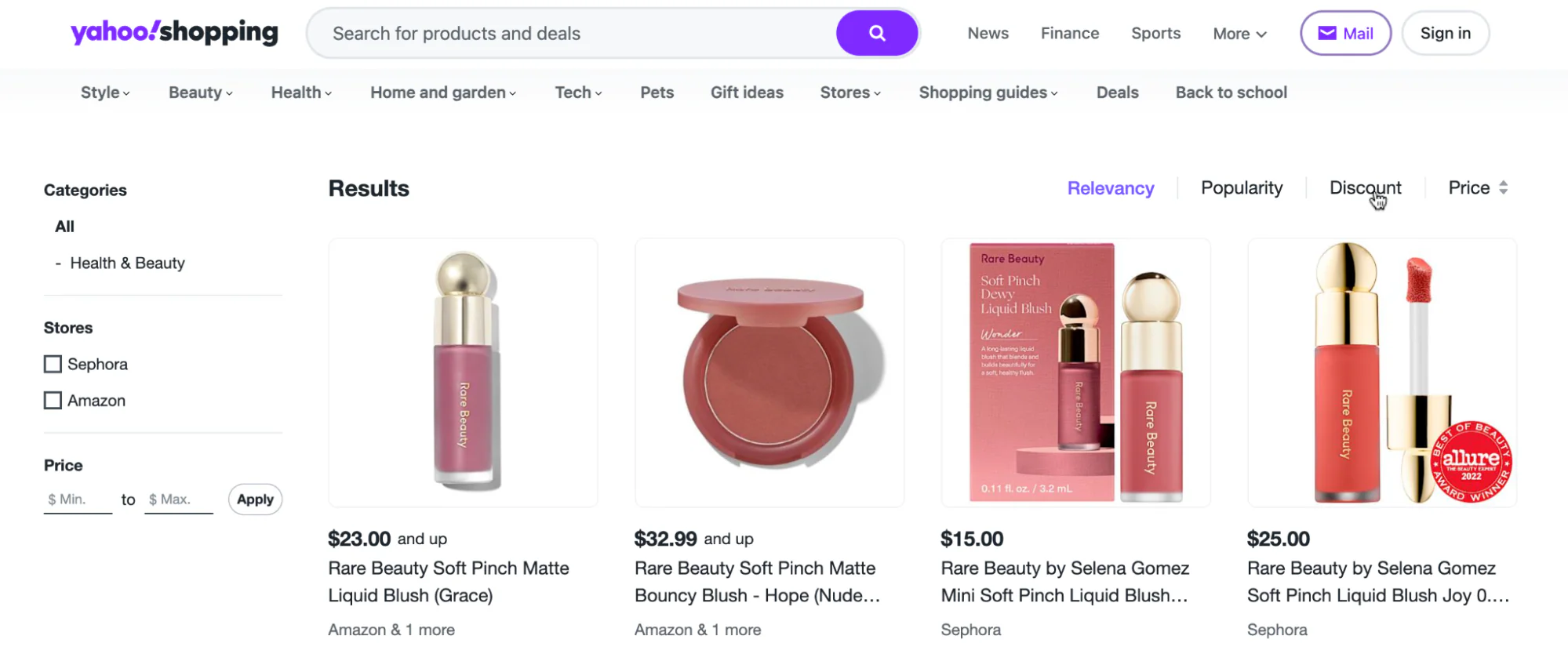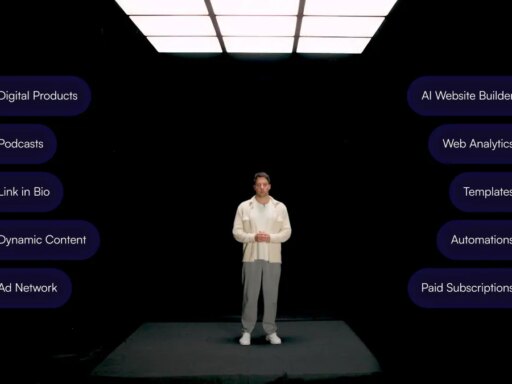Whether you’re working toward a specific savings goal or you’re frugal by nature, price comparison may be your shopping mode. Thanks to the internet, it’s also never been easier or more tempting to look for the BBD—the bigger, better deal.
The irony of modern shopping is that the simpler it gets, the harder it feels. Raluca Ursu, a marketing professor at NYU Stern, calls it “search fatigue.” And the stage that fries shoppers the most is comparing prices.
Now toss mobile into the mix. Experts project mobile commerce revenue to hit $2.5 trillion in 2025. Currently, mobile customers account for more than 50% of visitors to price comparison websites.
This means comparison shopping is more of a 24/7 reflex.People check prices in the cereal aisle, on the bus … maybe even in the bathroom.
For shoppers, the payoff is obvious: plenty of chances to save a buck or two. For merchants, the reality is a hyper‑competitive marketplace where the best deal is always just a tap away.
Enter price comparison tools. Ahead, you’ll see 26 of the best websites and apps to use in 2025—no matter which side of the aisle you’re on.
What is price comparison?
Price comparison is the practice of measuring the cost of the same product across multiple retailers. Online, it happens through price comparison websites (PCWs) or comparison shopping engines (CSEs), which display product prices, features, and reviews from different retailers in one place.
Here’s how price comparison websites work behind the scenes:
- They gather prices. The site pulls product and pricing data directly from retailers’ feeds or scrapes it from online stores.
- They match identical products. The site matches a “Nike Air Zoom Pegasus 40 in black, size 9” on Amazon to the exact same model on Foot Locker, so the results are fair.
- They add the extras. Shipping fees, sales tax, discount codes, and special offers get layered on top of the base price, so the comparison reflects the real cost.
- They display the options. A ranked list or grid lets shoppers see who’s cheapest, fastest, and has the best reviews.
- They refresh constantly. Prices change every hour (or sooner), so comparison sites update feeds regularly to stay current. Many even send price drop alerts so shoppers don’t have to keep checking back manually.
The result is a single screen where shoppers examine dozens of options—and where sellers compete head to head for the click:

TL;DR: 26 best price comparison apps and websites
| Price comparison tool/platform | Best for | Key features | Pros | Cons |
|---|---|---|---|---|
| Google Shopping | Large-scale exposure for products | Integrates with Google Ads; Price Competitiveness report | Huge reach; detailed merchant insights | Competitive CPCs; crowded |
| Shopzilla | Driving traffic via performance marketing | Millions of products; part of Connexity network | Access to a broad ad network | Stiff competition; high PPC costs |
| Become | Everyday shoppers hunting for deals | Reviews + product library | Combines reviews + pricing | Less merchant-focused |
| Bizrate | Engaging shoppers who set alerts | Price alerts + Connexity integration | Alerts drive repeat visits | Competition within Connexity |
| CamelCamelCamel | Amazon-specific deal hunting | Amazon price history + alerts | Historical charts; alerts | Limited outside Amazon |
| ShopMania | Cross-border ecommerce | PPC model + Facebook integration | Affordable visibility | Merchants must meet strict rules |
| Yahoo! Shopping | Casual shoppers tracking items | Price tracker + wishlist | Easy to use; strong brand name | Smaller footprint today |
| Pricepirates | Shoppers in EU/US looking across platforms | Global reach; eBay/Amazon results | Free; simple interface | Limited to major marketplaces |
| Twenga | Expanding reach into EU markets | Upload feed to list products | Boosts visibility; review integration | Heavily PPC-based |
| PriceRunner | UK/EU shoppers comparing retailers | Free to use; Klarna-backed | Trusted in Europe | Limited to selected countries |
| SkinFlint | Dropshippers & EU retailers | Wholesale + retail focus in EU | Good for bulk buyers | Niche; limited audience |
| Shopbot | Shoppers in CA/NZ/AU | Buyer guides + regional focus | Regional relevance | Not global |
| PriceBat | Office + electronics buyers in Canada | Canadian electronics focus | Great niche coverage | Narrow category focus |
| Getprice | Australian shoppers wanting local | Millions of AU products; city filters | Saves on shipping, localized | Limited to Australia |
| PriceSpy | UK/NZ shoppers tracking deals | Pricing history + filters | Transparent pricing history | Not global |
| Price.com | Deal-driven shoppers | Cashback + coupons + price alerts | Covers 100,000+ stores; cashback perks | Complex app interface |
| Slickdeals | Bargain hunters across categories | Community-vetted deals | 95,000+ App Store reviews, trusted | Deals can expire fast |
| Vetted | Shoppers overwhelmed by research | AI-powered recommendations + reviews | Summarizes expert + user reviews | Newer app, fewer reviews |
| ShopSavvy | In-store shoppers checking prices live | Barcode scanning + stock data | 10 million+ downloads; price match tool | Results vary by store data |
| BuyVia | iPhone/iPad users chasing deals | Coupons + barcode scanning (iOS only) | 4.6⭐ on App Store | No Android version |
| Barcode Scanner – Price Finder | Shoppers who want simple price checks | Instant scans, QR support, history log | 1 million+ downloads; 5.0⭐ on iOS | Fewer advanced features |
| Prisync | Shopify merchants optimizing strategy | Dynamic repricing; Excel exports | Automates pricing; email alerts | Paid app |
| PriceMole | Shopify merchants monitoring rivals | Competitor + stock tracking | Dynamic pricing; alerts | Requires setup |
| Price Compare (The App Geeks) | Merchants highlighting value | Shows competitor pricing on-site | Affiliate click-throughs possible | Risk of sending users away because of promotions |
| Equate – Product Compare | Merchants boosting discovery | Side-by-side product lists | Shareable lists; upsells | Only compares internal catalog |
| Lengow | Merchants scaling across platforms | Multichannel; affiliate; social selling | Analytics; retargeting | Complex for small shops |
Best US price comparison websites and apps
1. Google Shopping
Google Shopping is one of the largest and best-known price comparison sites for both shoppers and sellers. Products submitted to Google Shopping also appear in standard Google search results and integrate with Google Ads, the pay-per-click platform.
For merchants, Google has a price competitiveness report that shows competitor prices. Accessed through the Google Merchant Center, the report includes four metrics for comparing product prices against the competition:
- Your price. The current price of your product.
- Current benchmark price. The average click-weighted price for a product across all businesses that advertise that product with Shopping ads.
- Current benchmark price difference. The percentage difference between your product’s current price and the benchmark price.
- Historical benchmark price difference. The percentage difference between your product’s price and the benchmark price during a specific date range.
📚 Learn more:How To Create Google Shopping Ads for Your Store
2. Shopzilla
Since 1996, customers looking for deals have headed to Shopzilla. This comparison site lists millions of products, so the selection is vast and competition can be tough.
Merchants wanting to use Shopzilla to generate extra sales should know that it’s a Connexity company. That means you can also access its entire advertising network to find new customers and channels.
3. Become
Become has a large product library for shoppers to search. It allows shoppers to compare prices, read and write product reviews, and search for the best possible online shopping deals and lowest prices.
4. Bizrate
On top of showing product and price comparisons, Bizrate lets customers set price alerts for specific products. Bizrate is also a Connexity company, so merchants get access to performance marketing features for the open web.
5. CamelCamelCamel
CamelCamelCamel tracks Amazon product price histories over time, so shoppers can see historic pricing and trends. There’s also a browser extension with the option to receive price drop alerts. Consumers can browse by category or search for specific products to compare prices.
CamelCamelCamel offers versions of its price comparison tool for the US, the UK, Spain, Italy, Germany, France, Canada, and Australia.
6. ShopMania
ShopMania is a price comparison tool that runs on a pay-per-click model. Consumers browse the categories or conduct a search on the website, and you pay each time someone clicks on your product. ShopMania also works with Facebook selling.
To advertise your products on ShopMania, your business must:
- Be a fully functional ecommerce store
- Be legally registered and operating
- Have easy-to-find contact details
- Use the official language and currency of the country where you operate
7. Yahoo! Shopping
Yahoo! Shopping’s price tracking feature is a price alert tool for online shoppers. Consumers create a wish list with products they want to track price history for and Yahoo! will monitor price changes over time. Yahoo! Shopping also features deals for various products and discounts.
8. Pricepirates
Germany-based price comparison tool Pricepirates also offers versions for the US, Austria, Switzerland, and the UK. Consumers can scan top sellers and products by category or enter a specific search query for the item they’re interested in. Results are typically from eBay or Amazon. Pricepirates also has mobile apps for iOS and Android.
9. Twenga
Twenga is a price comparison platform that lets you upload your products to attract price-conscious customers. By listing on Twenga, you can increase your visibility and make it easier for shoppers to compare prices, features, and reviews, driving qualified traffic and boosting sales.
Best price comparison websites for global shoppers
10. PriceRunner
Klarna’s PriceRunner is a free-to-use price comparison engine that allows shoppers to compare prices from retailers all over the UK. Pricerunner is available for use in the UK, Germany, Sweden, Denmark, and Norway.
11. SkinFlint
Skinflint is a price comparison website that’s popular with dropshippers based in the UK and the EU. With Skinflint, shoppers and retailers search and compare products from wholesale retailers across Europe.
12. Shopbot
Shopbot allows shoppers to search and compare products from multiple retailers. Shopbot also has an extensive blog that includes buyer guides, product reviews, and advice on what to look for when purchasing specific products.
Shopbot is available for shoppers in Canada, New Zealand, and Australia.
13. Pricebat
PriceBat is a Canadian site for comparing product prices, with a focus on computer accessories and other electronics. For retailers in need of office supplies, PriceBat finds the best deals on printers, ink cartridges, and laptops.
14. Getprice
Getprice lists and compares products from Australian retailers, with city-specific filters for Australian buyers who want to save on shipping by purchasing locally. Getprice lists millions of products from hundreds of retailers across Australia.
15. PriceSpy
PriceSpy’s price comparison platform boasts a wide variety of products from retailers all over the UK. PriceSpy’s comprehensive search allows you to filter for specific brands and categories. Shoppers can even view the pricing history for some products, allowing them to see if the current price is lower or higher than before.
Best price comparison apps for iPhone and Android
16. Price.com
Price.com is a comparison, coupons, and cashback app rolled into one. It supports cashback across more than 100,000 stores, including big names like Target, Walmart, and Chewy. The app tracks more than a billion products in real time and offers automatic price comparisons—even while you’re browsing other apps or shopping online.
17. Slickdeals
Slickdeals is a community-driven price comparison and deal-sharing app where millions of shoppers post, vote, and surface the best discounts in real time. The app has been downloaded by more than one million users on Google Play and has a 4.8⭐rating on the App Store from nearly 95,000 reviews.
Every deal is community-vetted. Shoppers set up alerts, scan new posts, and pounce when the Frontpage section lights up with markdowns that are too good to miss. From laptops to laundry detergent, the hive mind does the work.
18. Vetted
Vetted is an AI-powered shopping assistant that does the heavy lifting: comparing prices, summarizing reviews, and recommending the best alternatives—all in one conversation. The app has more than 100,000 downloads on Google Play, and a 4.6⭐rating on the App Store from 11 reviews. (A good sign for a new AI tool signaling growing adoption.)
Instead of digging through reviews and juggling five retailer tabs, you just chat with Vetted. Ask for the best headphones under $300 or whether that air fryer’s worth it and it brings together expert opinions, user feedback, and live prices in one place.
Best barcode scanner price comparison mobile apps
19. ShopSavvy
ShopSavvy is a price comparison app with more than 10 million downloads and counting, designed for smartphones. Shoppers can either search a keyword or UPC code or scan barcodes. ShopSavvy will show product prices for the same or similar items online or at local retailers. It can also tell shoppers which stores have the most units in stock, and features a price match tool to help them get the best deal without seeking out the item elsewhere.
20. BuyVia
BuyVia is a slick, all-in-one app that scans for deals daily from top stores you actually shop at—Amazon, Target, Walmart, Best Buy—and sends them directly to you. The app aggregates discounts, prints coupons, and highlights flash sales. You can scan barcodes or QR codes in-store, build a wish list, and get alerts when items drop to your target price.
BuyVia holds a strong 4.6⭐rating on the App Store, based on nearly 2,000 reviews.
21. Barcode Scanner – Price Finder
Sometimes you just want to scan, compare, and move on. Barcode Scanner – Price Finder does exactly that. With more than one million downloads on Google Play (4.8⭐from 61,800 reviews) and a near-perfect 5.0⭐rating on the App Store (3,400 ratings), it’s one of the most trusted barcode comparison apps out there.
The app checks prices across major online retailers the second you scan a product. In addition to working in any orientation, the app keeps a history of all scans and allows you to share the results via text or email. It even processes QR codes, URLs, and product information signs without breaking stride.
Best price comparison websites and apps for Shopify merchants
22. Prisync
Dynamic Pricing Optimization by Prisync is a back-end tool that lets Shopify store owners collect competitor pricing. Adjust your pricing strategy accordingly or use the app’s dynamic pricing feature to automatically change your pricing based on the competitive landscape. You can also see stock availability, set email notifications, and export data in Excel.
💡Pro tip: Prisync integrates with Shopify to give you real-time competitor insights and dynamic pricing, helping you make smarter, faster moves.
23. PriceMole
Similar to Prisync, PriceMole tracks competitor pricing to inform your strategy. It also tracks stock levels, has dynamic pricing, and includes email alerts.
24. Price Compare by The App Geeks
The Price Compare app by The App Geeks pulls in competitor pricing and displays it on your Shopify site, letting you promote how low your prices are and how expensive the items are elsewhere. Though you don’t want users to click away from your site, those click-throughs can turn into earned affiliate sales—so there’s an upside.
25. Equate – Product Compare
Equate – Product Compare lets merchants pitch their own products against each other. Product Compare makes these lists shareable, so shoppers can send them to friends and family for their opinions. It also aids in product discovery, suggesting similar products to compare.
26. Lengow
Lengow incorporates social media selling, affiliate platforms, and ad retargeting. The tool comes with analytics reporting so you can optimize product listings to increase sales.
Features to look for in price comparison tools
When selecting a price comparison tool, there are essential features to consider, whether you’re shopping or selling.
For shoppers
- Real-time pricing updates. Regular updates ensure the prices you see are current and reflect recent changes, so you don’t miss flash sales or limited-time offers.
- Price history graphs. Historic information captures fluctuations in the price of a product over time, helping to identify the best time to buy.
- Price drop notifications. An option to set up alerts for products means you’ll always know when the price drops to a desired level.
- Barcode scanners. Available in mobile apps, this tool lets you scan a product’s barcode in-store and compare its price across various online platforms instantly.
- Community reviews and ratings. See what other buyers think about a product and whether they’re considering alternative merchants or items.
- Shipping costs and times. Free or low-cost shipping may offset a higher product price.
For sellers
- Easy integration. An app that simplifies adding and updating product listings from your store helps keep information current without excessive manual effort.
- High traffic and engagement. Ensure your partner platforms attract a substantial number of visitors, increasing the likelihood of sales.
- Analytics tools. Price comparison sites may offer insights into how your listings are performing against competitors, allowing for strategic price adjustments.
- Ad placement options. Some platforms have opportunities for featured product placements or advertisements.
How to choose the right price comparison tool
Here’s a quick decision checklist to help you sift through this massive list:
For shoppers
Do you mostly shop on Amazon and want to know if a sale price is actually a deal?
Use CamelCamelCamel for historical charts and alerts.
Do you find yourself checking prices in-store?
Download ShopSavvy or Barcode Scanner – Price Finder to scan barcodes and compare instantly.
Do you hate toggling tabs and reviews across multiple sites?
Chat with Vetted for one-stop recommendations, summaries, and live prices.
Do you trust the wisdom of the crowd to spot real bargains?
Go with Slickdeals, where deals are voted up by millions of users.
Do you shop outside the US and need reliable local comparisons?
Try PriceRunner or PriceSpy for UK/EU coverage.
For sellers
Do you need to keep prices competitive without constant manual checks?
Prisync or PriceMole automate repricing and send alerts.
Do you want your products to show up in front of the largest number of buyers?
List them on Google Shopping for massive reach.
Are you trying to expand internationally?
ShopMania or Twenga puts you in front of shoppers abroad through PPC listings.
Do you want to prove your prices are lower than competitors, right on your site?
Add Price Compare by The App Geeks to highlight the difference.
Do you want shoppers to compare your own products side by side for discovery?
Use Equate – Product Compare to guide them through options.
How to effectively use price comparison sites
For shoppers
Compare prices on multiple platforms
Don’t rely on a single price comparison site. Different sites may have exclusive deals or partnerships with certain retailers. By checking several platforms, you ensure that you’re truly finding the best price available.
Check the final price when all costs are added
A low price tag can be tempting, but don’t forget to factor in shipping costs, return policies, tariffs, and taxes.
Set up price alerts
Save yourself the daily refresh—a good price alert app will do the stalking for you and buzz your phone the second your product hits the right price.
For sellers
Format your product feed
Ensure your product feed is well formatted and meets the specifications of the comparison site. Include high-quality images, accurate descriptions, and competitive pricing. Regular updates to your feed can help maintain the accuracy and relevance of your listings.
Analyze and leverage platform data
If a price comparison platform shares user data with you, harness it to understand how users interact with your listings. Identify trends and adjust your pricing strategy or marketing efforts. If it’s a lot of data, let AI tools for business help. They sometimes spot patterns humans miss.
Optimize product visibility
Explore premium features on comparison sites that allow for better positioning or featured listings. Investing in ads or promoted listings can direct more potential customers to your products.
Benefits of price comparison
Retailers that list on comparison platforms see real gains: sales can jump by an average of 30%, and conversion rates climb by up to 25%. On the shopping side, more than 55% of consumers report feeling more confident in their buying decisions after comparing options.
This is why price comparison matters on both sides of the aisle:
- Save money with smarter choices. Avoid overpaying for the same product. Looking at multiple listings makes it easier to find the right balance between cost and quality.
- Uncover hidden gems. Comparison sites surface alternatives shoppers may not have considered, like smaller brands or bundle deals that deliver better overall value.
- Gain a competitive edge. For merchants, monitoring competitor pricing provides a clear picture of where you stand. Adjusting strategically helps maintain margins while still staying relevant to cost-conscious shoppers.
- Build trust with transparency. Consumers trust brands that make pricing easy to understand. Listing on comparison platforms signals honesty, which strengthens credibility and encourages repeat purchases.
- Inform your pricing strategy. Insights from competitor data allow merchants to fine-tune pricing, highlight value-added services, or create bundles that appeal to specific customer segments.
- Optimize promotions and discounts. Comparison data shows when and where discounts will have the most impact.
Grow your business with price comparison sites
If your products are listed with competitive prices, price comparison websites are an effective way to get in front of interested customers.
Whether you’re comparing your products or putting them up against the competition, comparison apps and features can be a great way to ease buyer hesitation and build confidence for shoppers.
Price comparison FAQ
How do price comparison sites work?
For consumers, price comparison sites work like a search engine, sourcing current product information and displaying offers from multiple retailers to show how they stack up against one another.
Some price comparison websites include features that allow users to track product prices over time, find coupon codes, or get notified about sale events.
For merchants, comparison sites have their own rules for integrating product feeds. You may need to pay a fee and submit the required content (product photos, URL, price, description, etc.) to have your products listed. Your products will then appear for relevant searches against comparable products ranked by price.
Comparison platforms can help you develop your own balanced pricing strategies. You don’t want to price yourself out of consideration, but you need to make sure you charge enough to turn a profit.
What’s the best website to compare prices?
It depends on what you’re shopping for. Google Shopping is the most widely used and works across categories, while niche tools like CamelCamelCamel are better for Amazon tracking, and ShopSavvy is handy for barcode scanning in-store.
How do price comparison sites make money?
Most use affiliate links, referral fees, or ads. Retailers pay a small commission when shoppers click through and buy from their listing, or they pay to feature their products more prominently.
Are price comparison apps safe?
Yes, reputable apps are safe to use. The main thing to watch for is data privacy: stick to well-reviewed apps from trusted sources like the App Store or Google Play.
How do I use Google to compare prices?
Type the product name into Google, then click the Shopping tab. You’ll see a list of retailers, prices, shipping costs, and ratings side by side.
Can voice search be used for price comparison?
Yes. Voice assistants like Siri, Alexa, and Google Assistant can pull price data for simple comparisons, though results are usually less detailed than a dedicated website or app.
What is the formula for price comparison?
There isn’t one universal formula, but the principle is simple: Final price = base price + shipping + taxes – discounts.
That’s the number shoppers should use when deciding who really offers the best deal.
Are comparison sites accurate?
While there may be discrepancies or timing lags in updating deals, price comparison sites are generally reliable for gaining an overview of market prices. To get the most out of price comparison sites, cross-reference prices with retailer websites, search engine results, and other comparison sites. Make sure to also take into account where the product is being shipped from, as well as the brand, material, and quality of the product.







